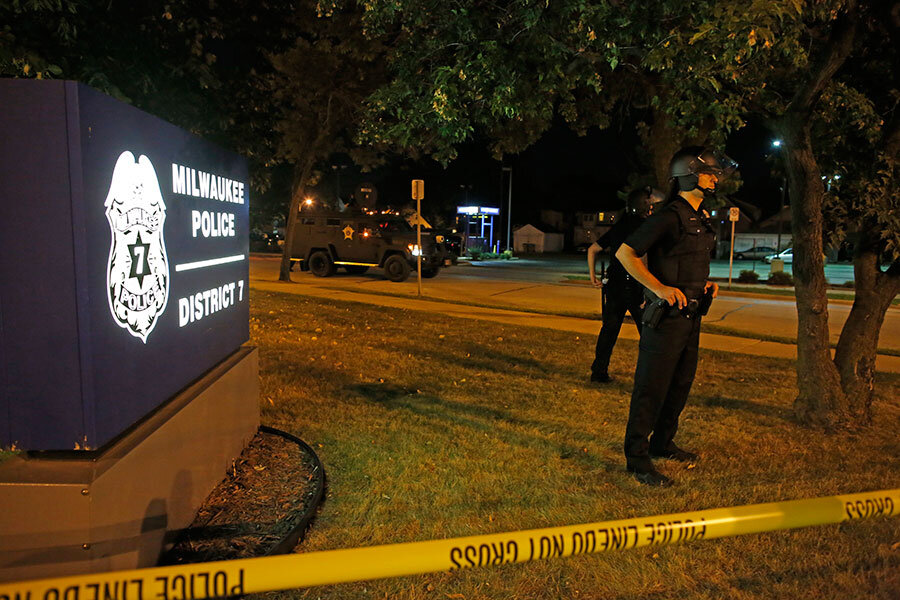How Milwaukee flipped the script after fatal police shooting
Loading...
When a routine traffic stop ended with a fatal police shooting last weekend in Milwaukee, it set off an increasingly familiar chain of events that included rioting, burning squad cars, and ransacked local businesses.
But what happened next was less familiar – police acting with restraint, and community members pointing their fingers not at police, but at the systemic issues they say are behind rising racial tensions.
On Saturday and Sunday nights, Milwaukee police deployed near where an officer shot and killed Sylville K. Smith after a traffic stop turned into a fatal foot chase. Both nights, protests turned violent.
Four officers have been injured, according to The Milwaukee Journal Sentinel. Seven squad cars have been damaged and six businesses set on fire. Officers also rushed a man, suffering from a serious gunshot injury, to the hospital Sunday night.
Yet officers have not responded with force. Milwaukee Police Chief Edward Flynn told the Journal Sentinel that officers have not used their firearms, Tasers, pepper spray, batons, or even used force by hand.
“I think police have showed a tremendous amount of restraint,” says Jim Bueermann, president of the Police Foundation.
“I don’t think people truly appreciate how hard it is to manage a situation like that,” he adds. “You can’t stand by and just watch people burn down the businesses of innocent people, and at the time same time you’ve got to control the rioters in a way that doesn’t create more problems and exacerbate the situation.”
Not black vs. blue
The restraint on the police side has been matched by a restraint among community leaders, who have not blamed the police, but said the upheaval is the product of systemic inequalities within Milwaukee’s black communities that have built over decades.
That focus on deeper issues matches a similar shift in the broader Black Lives Matter movement, which earlier this month released a platform of policy demands that goes far beyond protests against police brutality.
The mounting message is that police shootings, and the violent reactions they provoke, should not be reduced to a binary police-versus-blacks conflict, says Shawn Alexander, a professor of African and African-American studies at the University of Kansas.
Instead, these incidents should serve as a warning flare, pointing to how and where progress toward racial equality has stalled.
By not focusing on the controversy of the shooting itself, community members have opened “space for that discussion” on the broader systemic issues, says Professor Alexander.While body camera footage of the shooting exists, police haven't released it, citing the ongoing investigation into the incident. Chief Flynn has, however, taken the unusual step of describing some of the footage, telling reporters Monday that Mr. Smith turned “toward the officer with a firearm” before being shot in the chest and arm.
“People [in Milwaukee] have been quick to say it’s not about race only, it’s about policy, and if we want to simplify it and make it about race you’re missing the overall point,” says Alexander. “I think what we’re going to see is this is not just [the case in] Milwaukee.”
'The worst place to live for African-Americans'
Those policies, critics say, have given Wisconsin the worst incarceration rate for African-American men. At 12.8 percent, it is almost double the United States average, according to the 2010 Census.
In Milwaukee County, more than half of African-American men in their 30s and half of men in their early 40s have been incarcerated in state correctional facilities, and two-thirds of the county’s incarcerated African-American men came from six ZIP codes in the poorest neighborhoods of Milwaukee, according to a 2013 report by the Employment and Training Institute at the University of Wisconsin, Milwaukee.
Income inequality has been growing faster in Milwaukee than almost any other US city, according to a 2014 report from the Brookings Institution. Poorer neighborhoods also receive a disproportionately high number of costly citations from police.
Tensions worsened two years ago when the police shooting of Dontre Hamilton ended with the officer being cleared of any criminal charges.
At a midnight press conference on Saturday, barely nine hours after Smith’s death, Alderman Khalif Rainey brought up all these issues in describing the mostly black Sherman Park neighborhood as a “powder keg.”
“This entire community has sat back and witnessed how Milwaukee, Wis., has become the worst place to live for African-Americans in the entire country,” he said.
“Do we continue – continue with the inequities, the injustice, the unemployment, the under-education, that creates these byproducts that we see this evening?” he added. “What has happened tonight [with the riots] may not have been right; I’m not justifying that. But no one can deny that there are problems, racial problems, here in Milwaukee.”
“This was a warning cry,” he continued. “The black people of Milwaukee are tired. They’re tired of living under this oppression.”
Milwaukee's example
For their part, some police departments have been criticized recently for their reactions to riots after high-profile police shootings. The US Justice Department found that Ferguson police “violated citizens’ rights” during protests there in 2014, while a reputable law enforcement think tank found “major shortcomings” in how Baltimore police responded to the Freddie Gray riots last year.
Milwaukee police have so far avoided those mistakes.
“Most people in the position of those police would be chasing after the rioters, arresting as many people as they can,” says Mr. Bueermann, who says he experienced similar situations early in his career as a patrol officer in Redlands, Calif.
“Your emotions get very high, and your job as a police officer is to arrest people who are committing felonies, which these people are,” he adds. “But at the same time that might exacerbate an already tense situation.”






